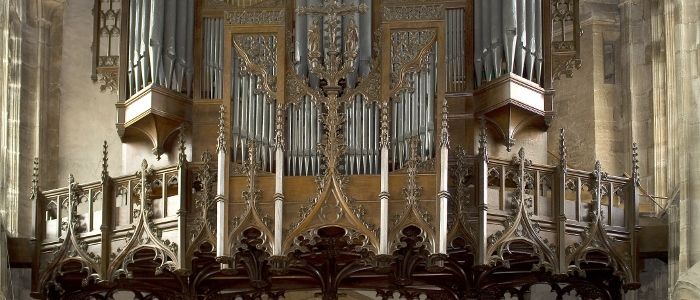The Organ
The use of an organ at Holy Trinity Church can be traced back to before the Reformation, when Richard Sharpe was 'pulsator organorum'. He was paid a yearly stipend of £6, granted by the king on the dissolution of the college. There is no further mention of an organ until Thomas Swarbrick built a new instrument in 1731 at a cost of £50. In 1815, the loft, on which the organ stood at the east end of the nave was enlarged to hold the charity girls as singers. At the same time it was repaired by William Allen of London.
The Swarbrick organ survived until 1841 when it was taken down in part-exchange for a new instrument built by William Hill, to a design by F. Marshall of Leamington. This organ was significant for it was one of the first organs in the country to have C-compasses and an independent Pedal division. It stood on a gallery at the west end of the nave, the size of the instrument almost obscuring the west window from view. In 1855 John Nicholson moved the organ to the north transept: this at the vicar's own expense!
Sometime before the Shakespeare tercentenary in 1864, a third manual was added by the Stratford organ-builder, Thomas Hewins. After Hewins' death in 1872 John Nicholson reported that the organ was in poor condition. Seven years later Nicholson fitted new manuals and pedals. He also regulated and repaired the action. During the 1880's the church was extensively restored and the organ moved. In 1889, a new decorated Gothic case designed by the church architects Bodley and Garner, was placed above the tower crossing in the nave. Thomas Hill placed the Great Organ and part of the Pedal Organ in this case. The rest of the instrument was disposed behind a screen at the eastern end of the south aisle. Unfortunately, the early form of electric action used proved so unreliable that it was replaced by the makers in 1898 with their patent tubular pneumatic action. At the same time alterations were made to the specification and the Great and Swell were exchanged, An increase in the volume of sound was made by opening up a new arch between the south aisle and the transept. In 1906, a case for this section was provided to a design by Tapper who had succeeded Bodley as church architect.
In 1937 a Grand Open Diapason was added to the Great Organ, a gift from a member of the congregation. Utilising some of the case pipes this rank was placed in the gallery and connected by electric action powered by batteries. The organ received no further attention until 1963 when Hill, Norman & Beard provided a new console and converted the action to electro-pneumatic. Some minor tonal alterations were also made at this time. However the work was not far reaching enough to prevent a general decline in the playing quality of the instrument.
The new organ by Nicholson & Co. Ltd., of Malvern reuses existing Hill pipework with some additions. It restores the intention of 1887 to place the Great, Swell and Pedal Organs together in the nave case from where they present a cohesive musical sound. A secondary organ providing for choir and service accompaniment, and containing much of the pipework suitable for the interpretation of the Romantic repertoire, is placed at ground level. The organ was dedicated at Evensong on 27th January 1991, by the Bishop of Coventry, the Rt. Rev. Simon Barrington.Ward.
Over autumn 2014, the organ underwent various improvement works, thanks to the generosity of the PCC and the legacy left by Miss Creak. Nicholson & Co. Ltd carried the works, which included replacing the Lower Swell (Swell II) shutters, adding a nazard and tierce on the Choir, a Cymbelstern in the Upper Organ, and super and sub octaves couplers to Swell I and II, and increasing the organ's divisional and general memory capacity, installing a stepper and sequencer memory system.




